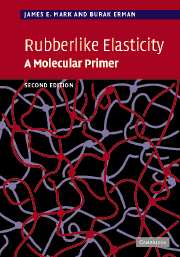Book contents
- Frontmatter
- Contents
- Preface to the first edition
- Preface to the second edition
- Part I Fundamentals
- Part II Additional topics
- 11 Networks prepared under unusual conditions
- 12 Strain-induced crystallization and ultimate properties
- 13 Multimodal networks
- 14 Birefringence and segmental orientation
- 15 Neutron scattering from networks
- 16 Liquid-crystalline elastomers
- 17 Bioelastomers
- 18 Filled elastomers
- 19 Current problems and new directions
- Appendix A Relationships between ν, ξ and Mc
- Appendix B Relationships between 〈r2〉, 〈(Δr)2〉, 〈r2〉0, and ϕ
- Appendix C Equations of state for miscellaneous deformations from the constrained junction theory
- Appendix D Thermodynamics of the relationship of stress to temperature
- Problems
- Answers to problems
- Some publications describing laboratory/classroom experiments or demonstrations
- References
- Index
19 - Current problems and new directions
from Part II - Additional topics
Published online by Cambridge University Press: 04 December 2009
- Frontmatter
- Contents
- Preface to the first edition
- Preface to the second edition
- Part I Fundamentals
- Part II Additional topics
- 11 Networks prepared under unusual conditions
- 12 Strain-induced crystallization and ultimate properties
- 13 Multimodal networks
- 14 Birefringence and segmental orientation
- 15 Neutron scattering from networks
- 16 Liquid-crystalline elastomers
- 17 Bioelastomers
- 18 Filled elastomers
- 19 Current problems and new directions
- Appendix A Relationships between ν, ξ and Mc
- Appendix B Relationships between 〈r2〉, 〈(Δr)2〉, 〈r2〉0, and ϕ
- Appendix C Equations of state for miscellaneous deformations from the constrained junction theory
- Appendix D Thermodynamics of the relationship of stress to temperature
- Problems
- Answers to problems
- Some publications describing laboratory/classroom experiments or demonstrations
- References
- Index
Summary
Listed below are some aspects of rubberlike elasticity which are clearly in need of additional research (Mark, 2004a, b). Most have already been mentioned or will be obvious from the discussions in the preceding chapters.
Improved understanding of dependence of the transition temperatures Tg and Tm on polymer structure
Preparation and characterization of “high-performance” elastomers
New cross-linking techniques
Improved understanding of network topology
Generalization of phenomenological theory
More experimental results for deformations other than elongation and swelling
Better characterization of segmental orientation, and its effects on strain-induced crystallization
More detailed understanding of critical phenomena and gel collapse
Additional molecular characterizations using NMR spectroscopy and various scattering techniques
Study of possibly unique properties of bioelastomers
Improved understanding of reinforcing effects of filler particles in a network
Quantitative interpretation of the toughening effects of elastomers in blends and in composites, particularly the polymer-modified ceramics
Environmental concerns ranging from elastomer synthesis to recycling
There is a real need for more high-performance elastomers, which are materials that remain elastomeric to very low temperatures and are relatively stable at very high temperatures. Some phosphazene polymers (Mark et al., 1992a, 2005b) are in this category. These polymers have rather low glass transition temperatures in spite of the fact that the skeletal bonds of the chains are thought to have some double-bond character. There are thus a number of interesting problems related to the elastomeric behavior of these unusual semi-inorganic polymers. There is also increasing interest in the study of elastomers that also exhibit the type of mesomorphic behavior described in Chapter 16.
Information
- Type
- Chapter
- Information
- Rubberlike ElasticityA Molecular Primer, pp. 211 - 214Publisher: Cambridge University PressPrint publication year: 2007
